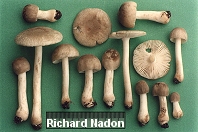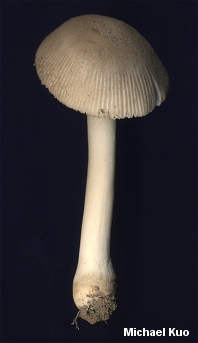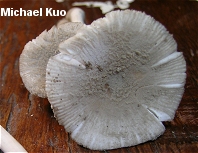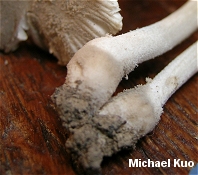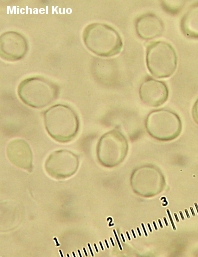| Major Groups > Gilled Mushrooms > Pale-Spored > Amanita > Amanita farinosa |

|
Amanita farinosa [ Basidiomycetes > Agaricales > Amanitaceae > Amanita . . . ] by Michael Kuo Here is a small, ringless Amanita species that is fairly easily distinguished from the ringless species centered around Amanita vaginata, since it lacks a sacklike volva, and features a cap and stem that are covered with fine, mealy powder. The powder is likely to wear away in maturity, or during the process of picking the mushrooms and bringing them home, but it will be present on young, fresh specimens. Even without the powder, however, the species is fairly unmistakable on the basis of its relatively small size, its dirty brown colors, its lack of a ring or volva, and its slightly bulbous stem base. Amanita farinosa in the sense of Thiers (1982) is a much larger and stockier West-Coast mushroom that is probably a separate species. Description: Ecology: Mycorrhizal with hardwoods or conifers; sometimes appearing in urban, grassy areas near trees; growing alone, scattered, or gregariously; early spring to late fall; widely distributed east of the Rocky Mountains, from Quebec to Costa Rica--though a similar western species is probably undescribed (see comments below). Cap: 2.5-6.5 cm; convex at first, becoming convex or nearly flat; dry; the surface dusted with fine, mealy powder which rubs off easily; occasionally with the powder gathered into a few scattered warts or patches; the margin prominently lined for 1-2 cm by maturity; brownish gray to brownish or nearly whitish; bald. Gills: Free from the stem or slightly attached to it; whitish; close; short-gills few. Stem: 3-9 cm long; 3-10 mm thick; more or less equal above a slight basal bulb that is often covered with grayish powder like the cap (sometimes only as a smear on the upper edge of the bulb); whitish; bald or slightly silky; without a ring; solid or partially hollow in age. Flesh: White; not staining on exposure. Odor: Not distinctive, although one author claims there is a: "strong, mink smell in old specimens" (Phillips, 1991). What I want to know is: Why was Roger Phillips sniffing a mink? Spore Print: White. Microscopic Features: Spores 5-8 x 5-6 µ; smooth; broadly lacrymoid to subamygdaliform; inamyloid. Pileipellis a cutis or ixocutis of elements 2-7 µ wide. Basidia 4-spored; unclamped. Lamellar trama bilateral; subhymenium with inflated cells. REFERENCES: Schweinitz, 1822. (Jenkins, 1977; Smith, Smith & Weber, 1979; Weber & Smith, 1985; Jenkins, 1986; Phillips, 1991/2005; Lincoff, 1992; Barron, 1999; Roody, 2003; McNeil, 2006; Miller & Miller, 2006; Binion et al., 2008.) Herb. Kuo 06180402, 07100701, 07070805, 07300905. This site contains no information about the edibility or toxicity of mushrooms. |
© MushroomExpert.Com |
|
Cite this page as: Kuo, M. (2013, April). Amanita farinosa. Retrieved from the MushroomExpert.Com Web site: http://www.mushroomexpert.com/amanita_farinosa.html |
